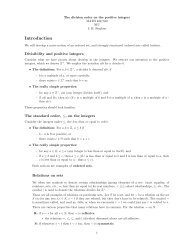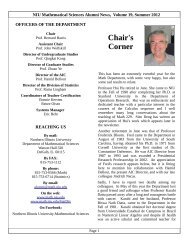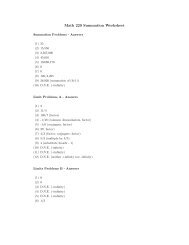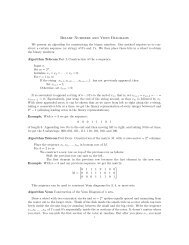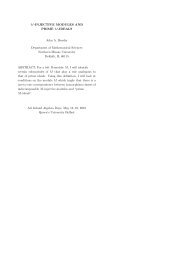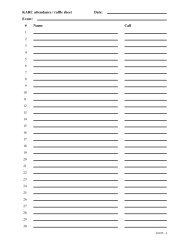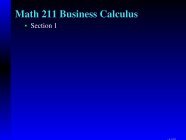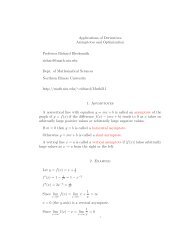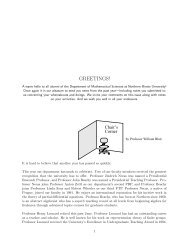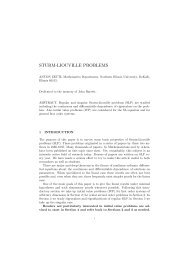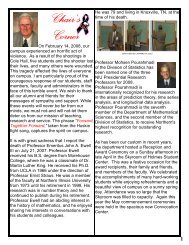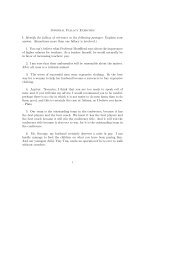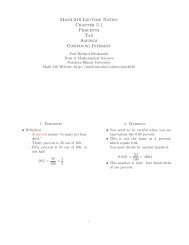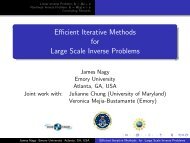Nine Point Circle and Feuerbach's theorem
Nine Point Circle and Feuerbach's theorem
Nine Point Circle and Feuerbach's theorem
Create successful ePaper yourself
Turn your PDF publications into a flip-book with our unique Google optimized e-Paper software.
<strong>Nine</strong> <strong>Point</strong> <strong>Circle</strong> <strong>and</strong> Feuerbach’s <strong>theorem</strong><br />
First, a few terms to refresh our memory. Given a triangle △ABC, its orthocenter is the point where the<br />
three altitudes intersect. For example, the orthocenter of a right triangle is its vertex at the right angle. Where<br />
is the orthocenter of an acute triangle <strong>and</strong> an obtuse one We will label the orthocenter with H. [I might<br />
add some illustrations later when I have more time.]<br />
The circumcenter, the center of a circumscribed circle, is the common intersection of perpendicular bisectors<br />
of sides. This is easy to see if we start with any circle, then draw any triangle with vertices on the circle,<br />
<strong>and</strong> look at the relative position of the center of the circle <strong>and</strong> any two vertices. If you have a compass <strong>and</strong><br />
know how to use it with a ruler to find a perpendicular bisector of a segment, you can now easily find the<br />
circumcenter of any triangle. This allows you to construct the circle circumscribed around the triangle. Let’s<br />
label the circumcenter O.<br />
Finally, the centroid of △ABC is the intersection of the medians, i.e. the segments connecting each vertex<br />
with the midpoint of the opposite side. We will call it G.<br />
Now construct a unique circle C passing through the midpoints L, M <strong>and</strong> N of the three sides (can those<br />
midpoints ever be collinear, i.e. lie on a single straight line when they are, they do not define a circle with<br />
finite radius!)<br />
This is the so-called nine point circle. The reason for the name is that it passes through 9 points closely<br />
related to the triangle we started with. For starters, it passes through the midpoints of the three sides (i.e.<br />
through the feet of the medians) – that’s how it was constructed. Let’s look for six more points.<br />
Observations (Poncelet, Feuerbach, others)<br />
It turns out that C also passes through the three feet D, E, F of the altitudes of △ABC (so we could have<br />
started by constructing the unique circle through these three points, <strong>and</strong> then our first claim would be that it<br />
has to pass through the feet of the medians). We have three more points.<br />
The next three are a little stranger. Remember H, the orthocenter Draw segments connecting it with the<br />
vertices of the triangle, i.e. AH, B H, C H. Their midpoints are the so-called Euler points of △ABC, named<br />
after the famous mathematician Leonhard Euler. It turns out that C also passes through those points, <strong>and</strong><br />
that makes 9.<br />
There are more quite surprising properties. For example, as Euler noticed, the three points H, O <strong>and</strong> G lie<br />
on a line (called the Euler line). The center of the nine-point circle must lie on this line also.<br />
Further, if one draws the tangents to the circle C at points L, M, N, they will form a triangle whose sides<br />
are all parallel to the sides of △DE F, the triangle formed by the feet of the altitudes, often called the orthic<br />
triangle. So in particular the triangle formed by the tangents to C at L, M, N is similar to the △DE F.<br />
Feuerbach’s Theorem<br />
Finally, Karl Feuerbach proved two more statements about C. Recall that the incircle is the inscribed circle<br />
of △ABC. You can find it by locating the common intersection of the bisectors of the interior angles of
△ABC – this will be the incenter of the triangle, i.e. the center of the unique inscribed circle. Feuerbach<br />
showed that our C is always tangent to the incircle, i.e. they touch, <strong>and</strong> at one point only.<br />
Now for the last step. Extend the sides of the triangle so that you will have three “nooks”, regions outside<br />
the triangle each bounded by one side of △ABC, <strong>and</strong> two extensions of the other two sides. In each of these<br />
“nooks” you can draw a unique circle tangent to these three “walls”. These circles (called the excircles of<br />
△ABC) will typically be quite large, <strong>and</strong> will all live on the outside of the triangle. It turns out that each of<br />
them is again tangent to C.<br />
All this is relatively basic geometry, dating back to the early 19 th century.<br />
You can probably find some more information by searching groups.google.com for words such as “Euler<br />
line”, “Feuerbach’s <strong>theorem</strong>”, etc.<br />
2



